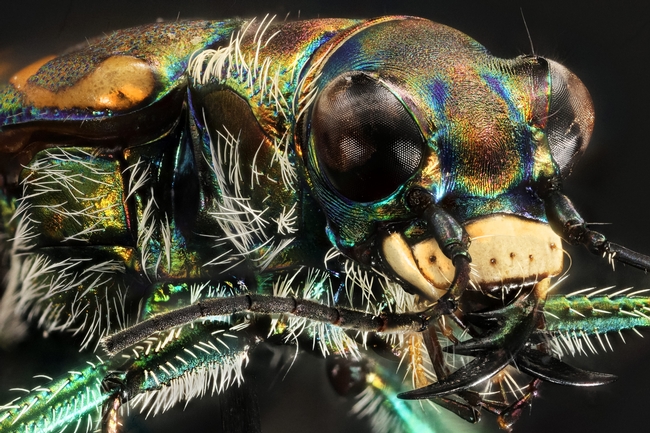
Are there tigers in Yellowstone National Park?
Yes, tiger beetles. They live in the thermal pools, are one of the fastest animals on earth and in size, can fit on your thumbnail.
Robert K. D. 'Bob' Peterson, professor of entomology at Montana State University (MSU), Bozeman, and the 2019 president of the Entomological Society of America (ESA), will speak on "Tigers in Yellowstone National Park: Insect Adaptations to Extreme Environments" at the UC Davis Department of Entomology and Nematology's online seminar on Wednesday, March 31. His seminar, hosted by UC Davis distinguished professor James R. Carey, a fellow of ESA, begins at 4:10 p.m. Access this Google document to attend the Zoom event.
"Tiger beetles (Cicindela haemorrhagica) live, feed and breed in the hot, acidic, toxic channels of Yellowstone's thermal features," according to Yellowstone National Park officials. (See photo on Flickr.) "Researchers are investigating how their body structure, behavior, and unique heat shock proteins protect them from 50 Celsius (122 Fahrenheit) heat, corrosive acid, and heavy metals. But once they die, they are quickly coated by the same mineral deposits that shape their habitat. Removal of these minerals in an ultrasonic cleaner reveals the white tiger beetle's stunning true colors."
Peterson manages the website, Insects of the Greater Yellowstone Ecosystem, an online photographic celebration of the ecosystem's biodiversity. He describes it as a "celebration of the "incredible diversity and abundance of insects in the area." Peterson categorized the site into butterflies and moths; beetles; flies; true bugs; stoneflies; mayflies; net-winged insects; bees, wasps ants and sawflies; grasshoppers, crickets and katydids; and insect relatives. Peterson also hosts a comparable Facebook page, Insects of the Greater Yellowstone Ecosystem.
Peterson, with MSU's Land Resources and Environmental Sciences, leads the research, teaching and outreach program in Agricultural and Biological Risk Assessment, a program centered on comparative risk assessment. His other areas of research include insect ecology, plant-stress ecophysiology, and integrated pest management. Peterson teaches undergraduate and graduate courses, including environmental risk assessment, insect ecology and various special-topics graduate courses. He also directs MSU's professional master's degree program in environmental sciences.
A native of Perry, Iowa, Peterson received his bachelor's degree in entomology from Iowa State University, Ames, and his master's degree and doctorate in entomology from the University of Nebraska, Lincoln. He joined the MSU faculty in 2002 after serving as a research biologist for Dow AgroSciences, Omaha from 1995 to 2001. He has published 123 peer-reviewed journal articles, 15 book chapters, and two books.
In addition to Insects of the Greater Yellowstone Ecosystem, Peterson is affiliated with two other websites, Insects, Disease and History, devoted to "understanding the impact that insects, especially insect-borne diseases, have had on world history"; and Ag Biosafety, designed to be a "definitive source of scientific, regulatory and educational materials relevant to crop biotechnology and the current debate on the genetic modification of food."
Cooperative Extension specialist Ian Grettenberger coordinates the spring seminars. For technology problems, contact him at imgrettenberger@ucdavis.edu.
- Bob Peterson
- Bob Peterson
- Cicindela haemorrhagica
- Cicindela haemorrhagica
- Montana State University
- Montana State University
- tiger beetles
- tiger beetles
- UC Davis Department of Entomology and Nematology
- UC Davis Department of Entomology and Nematology
- Yellowstone National Park
- Yellowstone National Park
Attached Images:
